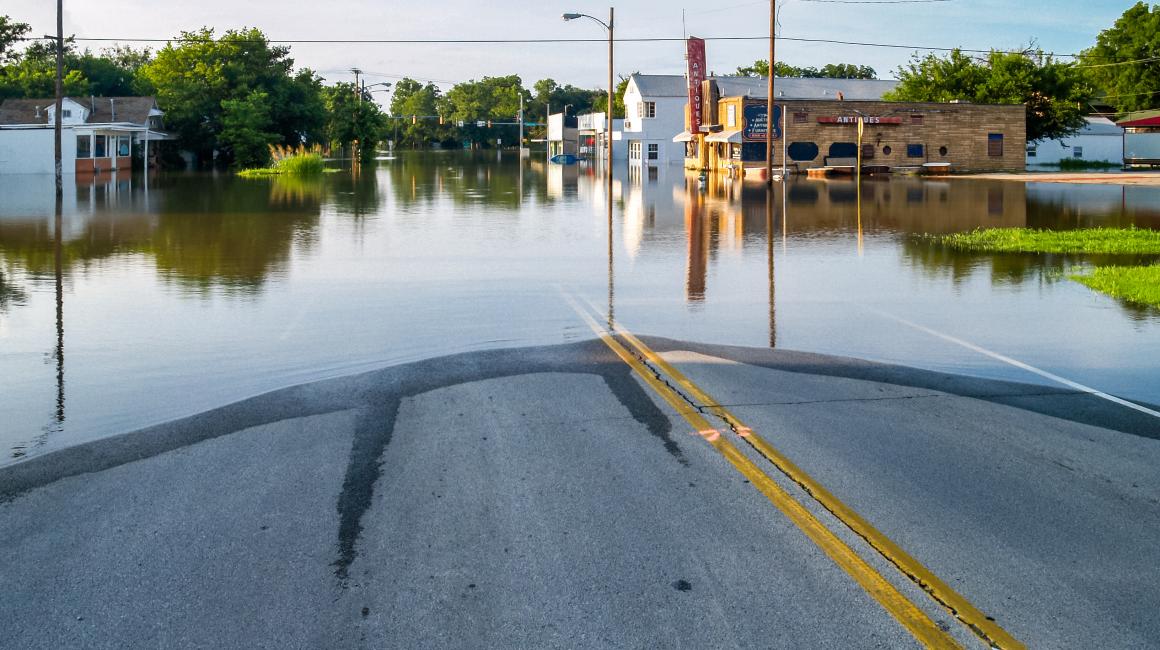
Media contact: Kristin Palm | [email protected] | 313-593-5542
As summer ramps up, the potential for intense rain and flooding increases, especially in urban areas. University of Michigan-Dearborn geology professor Jacob Napieralski talks about what U.S. cities can expect, the outsize impact on flooding in low-income neighborhoods — and how communities can best prepare.

Napieralski specializes in urban environments, water, historical mapping and flood risk equity. He recently published a study on the impact of buried streams and wetlands on flooding in historically redlined Detroit neighborhoods.
How much flooding should our cities expect this summer?
That’s the question everyone wants an answer to. But predicting the next flood is nearly impossible, so we can only rely on reporting the probability of a flood. Of course, we have short-term projections for weather, but it's really hard to say, “In July, we're going to be hit with a really bad event. Brace yourself.” So we play the probability game, and it's based on historical records and observations and then we combine that with forward-thinking models that tell us how the environment is changing.
With hotter summer days, for example, we expect more intense precipitation events, and those are the events that overwhelm infrastructure and cause flooding. So should we expect a flood? We should. But will the next flood impact everyone equally? No. Is it something that, once we experience it, we're done for the summer? Again, no. We are beginning to see relatively rare flood events occur more than once in a year. It's a probability game, but the more we understand the capacities of our urban stormwater infrastructures and about rapidly changing, localized climate, the better we are at projecting the next flood event and the impact it will have on communities.
Is flooding no longer exclusively a spring and summer thing?
Flooding is certainly no longer just a one or two season event. It's something that is now a four-season problem. In Michigan, we are experiencing quicker transitions from winter to spring and, in general, a shorter winter season. Sporadic warm days in the winter might correspond with winter flooding. Rain falls on frozen ground, and since water cannot percolate into the soil, the frozen ground acts like impervious material. This causes winter flooding. So in the winter, smaller precipitation events may actually cause more intense flooding than the same event in the summer.
Why are urban areas more prone to flooding?
Urban floods are not caused by a single reason. Urban areas are built with a lot of concrete and rooftops, which are not pervious, so water has no place to go but horizontally. Water naturally flows toward low spots in the landscape, which tend to be rivers and wetlands, but also human-made structures. That’s why you see the really memorable flood pictures in the news, with people kayaking underneath freeway bridges, because that's a depression and the excess water has overwhelmed the stormwater system and has no other place to go.
Also, there are more people in cities. Rural areas have very low density populations. So a farmer can get hit with a devastating flood that has minimal impact on other farmers in the area. The devastation means everything to that farm family, but if that same event hits an urban area, there are entire communities that can be underwater. In most rural areas, the priority is to direct the water away from homes and properties, but in cities, we have fewer options and sometimes must capture flood water, treat it, and then slowly release it once the flood recedes. We can't just let water do its own thing because urban flood damage is expensive and problematic.
The Environmental Protection Agency recently announced the availability of nearly $41 million in funding to help communities address stormwater and sewer infrastructure needs. How should these federal dollars and other resources be directed?
That’s a good question for each municipality and water authorities, as they know the quality or limitations of their stormwater systems. But it is important to stress that a lot of research shows that socioeconomically vulnerable communities have some of the highest risks, including urban heat, but also urban flooding. Many of these communities have more impervious surfaces and less green space than in high income communities. It seems equitable to consider these communities as priorities with funding opportunities to update stormwater and sewer infrastructure.
Beyond infrastructure upgrades, are there actions communities can take to minimize flood risk?
Keep in mind there are mitigation measures — those that actively work to reduce flooding — and adaptation measures, which accept flooding as a new normal and attempt to minimize the impact of flooding. These measures can be part of larger watershed initiatives, or priorities for municipalities, or even be implemented by homeowners who are actively working to protect their property.
We have learned the importance of using nature-based solutions to reduce the impact of excess heat and flooding in urban areas. A relatively simple approach is to increase the greenness of neighborhoods through gardens and trees. Trees offer some protection from heat and contribute to the uptake of excess flood waters. Although this is a small solution, the ecosystem services offered by trees and urban gardens are actually substantial.
Other inventions include building levees or other structures to divert water, or relying on pervious materials that reduce runoff during rain events. Some buildings and even individual homes capture gray water, frequently from rooftops, and then reuse that water to support lawns or flushing toilets.
Watershed education is also critical — informed citizens tend to make good decisions about their communities, so interacting with residents, school-aged children and small business owners can yield very positive results. While some of these interventions seem small, if a lot of people are doing it, then it reduces the stress put on stormwater systems.
###





